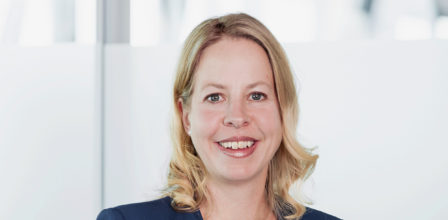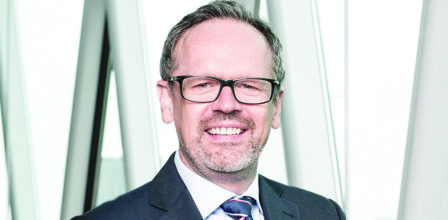Why diverse teams outperform homogenous teams – and harnessing the power of diversity is a win-win for people and business
Camilla Udd has been Head of Culture, Diversity and Change at Quoniam for a year now. In the interview, she talks about her work in the area of Diversity & Inclusion and explains why diverse teams outperform homogenous teams – provided an inclusive workplace culture is in place.

Camilla, what are your responsibilities as Head of Culture, Diversity and Change? How would you describe your role for someone who has never met you?
My job is to create value to our people and the business through high impact measures within organisational development, culture transformation and diversity & inclusion (D&I). I advise and support Quoniam in defining the organisation’s D&I strategy and bringing it to life. To do this, I work particularly close together with management, especially in defining the strategy, but also with colleagues in Communications and People & Development. However my work can only be successful if I connect with many different colleagues across the whole firm.
When you started at Quoniam, what were your first priorities in terms of D&I?
Getting to know the people, the organisation and the business. To do so, I asked a lot of questions: How is D&I currently viewed and addressed? Have we already established certain practices and initiatives that work well? What aspects should we get started with? No organisation starts completely from scratch, and there is also no patent formula that you can apply everywhere.
“No organisation starts completely from scratch in terms of D&I, and there is also no patent formula that you can apply everywhere.”

Camilla Udd
Head of Culture, Diversity and Change
To choose first priorities and derive the appropriate next steps, I have talked to both managers and employees. In D&I, everyone can make a difference, but dialoguing with management is particularly crucial because they are role models. I conducted interviews with all management members to get their collective understanding on what D&I aspects they find most important and why. This builds the foundation of our 5-year strategic D&I vision.
Engaging with the organisation is a key principle in the work we do around D&I. Including input from the whole organisation creates a high level of acceptance for D&I measures and increases their relevance by giving everyone the chance to discuss and help shape them. For example, we recently conducted focus group sessions in which colleagues from different areas of the firm exchanged their views and gave input on our D&I learning journey and D&I commitment statement.
Working with D&I is not a sprint, but a marathon. Sure, you can celebrate successes, grow and develop, but when working with D&I you need to think long-term and stay on your toes to guide the work in line with the needs of your people, business and other stakeholders. Another important thing to mention is the meaning of inclusion. The benefits of diversity can only be harnessed in an inclusive workplace. Diversity without inclusion is like inviting someone to a party and then not offering them any food or drinks, or not allowing them to dance!
“Sometimes D&I is perceived as either good for people or businesses. By now we know that D&I helps both people and businesses to thrive!”

Camilla Udd
Head of Culture, Diversity and Change
How can we benefit from D&I as a business?
Sometimes D&I is perceived as either good for people or businesses. By now we know that D&I helps both people and businesses to thrive. Research shows that diverse teams combined with an inclusive working environment boost innovation and improve decision-making. It brings more perspectives and solutions to the table, which when considered lead to better results. And it enables firms to better respond to all their stakeholders.
In the end, it is also about people. The financial industry is a people’s business that relies heavily on personal skills. An inclusive workplace where your full self is accepted and you are, for example, not obliged to hide aspects of who you are, has a huge impact on the wellbeing of employees. This, in turn, is linked to performance and leveraging the full potential of everyone. No organisation can afford to ignore this.
“Diverse teams combined with an inclusive working environment boost innovation and improve decision-making.”

Camilla Udd
Head of Culture, Diversity and Change
What are the challenges and opportunities of establishing D&I measures?
There are three things I would like to point out: different perceptions of the topic D&I, the occasional awkwardness of diverse teams, and the long-term aspect.
As I said, managers on all levels have a responsibility to promote D&I. At the same time, we can all make a difference. Each of us must ask ourselves questions like: Do I actively seek out other opinions from colleagues with different perspectives? Am I open to new input? Even if it sometimes seems abstract, D&I is very personal. It ties in with your values and beliefs, which are the core of who you are, formed by your upbringing and worldview, and difficult to change. Therefore we all have different perceptions of this topic.
Secondly, it is human nature that we mostly seek the advice of people who are similar to us, and that we do not like to talk to colleagues who contradict us or give pushback. At the same time, research shows that diverse teams outperform homogenous teams – provided they have proper rules of engagement and interaction. One example for this could be senior management seeking the advice of recent new joiners, or people outside of the investments area sharing product ideas.
“Research shows that diverse teams outperform homogenous teams – provided they have proper rules of engagement and interaction.”

Camilla Udd
Head of Culture, Diversity and Change
Thirdly, working with D&I is a constant learning process. It is OK to make mistakes or admit that we do not know. I remember when the Black Lives Matter movement emerged in 2020. I personally learned a lot then through the insights of my former colleagues, for example on their experiences with everyday racism. No one ever knows everything, and that’s fine. What we can do is to stay open-minded, invite different perspectives and learn from each other.
Can you name some examples of D&I activities at Quoniam?
First of all, it was important to define why D&I matters and to set ourselves a D&I vision in which we outline where we want to be five years from now. Being clear about where we want to be is important, as it enables us to follow-up on our progress. The vision addresses many aspects, inter alia leadership and self-leadership, building an inclusive workplace, a D&I learning journey (e.g., awareness trainings) as well as establishing partnerships within and outside our industry (e.g., with universities) that enable us to exert broader influence.
“No one ever knows everything, and that’s fine. What we can do is to stay open-minded, invite different perspectives and learn from each other.”

Camilla Udd
Head of Culture, Diversity and Change
Of course, the D&I vision is aspirational and at a high level. To ensure we break that down and make it a reality, we create a D&I roadmap annually that schedules concrete activities. So far this year we have, for example, conducted a diversity theme week focusing on cognitive diversity with a keynote session and a panel discussion for our employees, combined with launching a practical “toolbox” on how to harness cognitive diversity. We have planned the D&I learning journey and initiated awareness trainings for all leaders. Currently we are reviewing the recruitment process from A-Z through a D&I lens and in the process of developing strategic D&I goals.
So, there is a lot going on and I look forward to accompanying the next stages of our D&I journey at Quoniam to add value to our people and business!
Thank you for the exciting insights!


